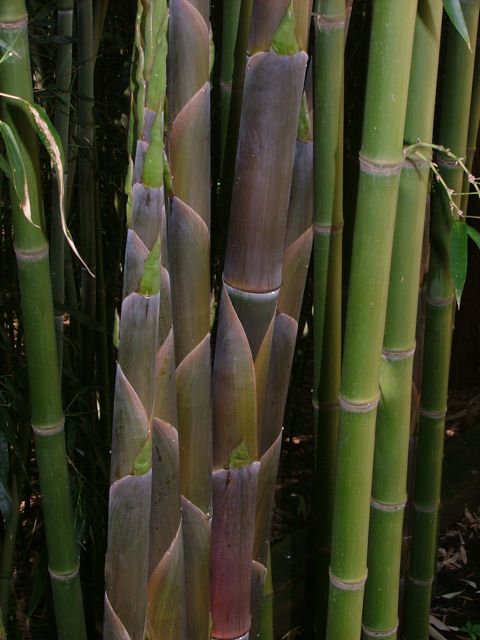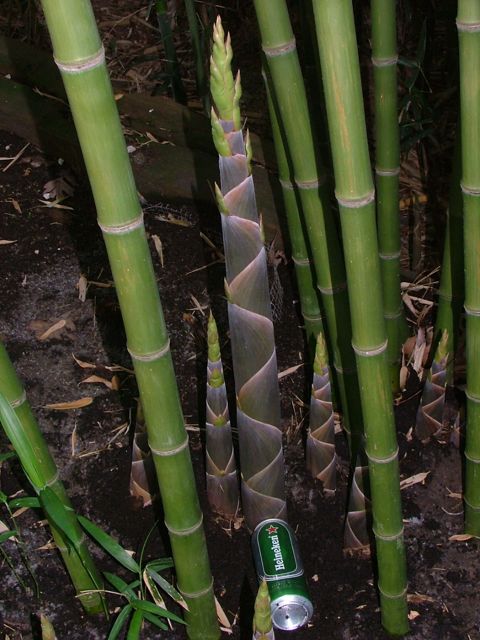I have frequented many bamboo discussion forums over the last 15 years and I’ve noticed a couple of recurring questions from new bamboo enthusiasts, one of which I hope to shed light upon here. An oft repeated topic regards bamboo identification. Many times I’ve seen posts requesting an ID of either a newly acquired pot of bamboo or a grove that someone discovered while out & about. The poster is careful to get close up photos of the leaves & branches and to also include some profile shots. The usual reply by forum members is either no reply at all or more likely a quick reply basically telling the inquirer to forget about it, not gonna happen. With other types of plants it can be fairly easy to get an identification of the species merely by posting a picture on the appropriate plant forum. With bamboo it is very difficult to properly ID species from photos of the foliage – and nearly impossible to ID potted bamboo plants.
NOT BAMBOO!
Before I go any further with bamboo ID’s I’d like to ID 3 plants that are NOT BAMBOO. A high ratio of bamboo ID requests regard these 3 non-bamboo.
Lucky Bamboo may well be lucky but it isn’t bamboo, rather it is a plant named Dracaena sanderiana.





Looking for Clues
With a few exceptions bamboo foliage is generally inadequate for providing clues as to the species. The exceptions include species that have unique features that can be easily recognized. An example is Phyllostachys aurea in a mature grove. The lower portions of some of the culms in the grove will contain distorted nodes/internodes mostly unique to Phy aurea such as in the photos below from the Bambooweb.info database.

These compressed lower internodes are rarely exhibited in other species, but only mature groves will display this feature. Still, I have found that young Phy aurea plants often will have a swollen portion just below the node such as in this 2nd photo – notice how about a half-inch below the branches the cane/culm suddenly becomes narrower? This feature is not limited to Phy aurea but it is a good clue in combination with other factors. In the Phy aurea clan there are several forms generally considered cultivars/sports of the plain green form but with some differences in culm or leaf coloration but all members will share the unique characteristics of the type form. So if you are looking for an ID of a bamboo with compressed internodes then start with the Phy aurea clan and see if you can hone in on which cultivar it is. Another clue of this family of bamboo is that they tend to start branching lower down than on other members of the Phyllostachys genus.

In a very broad sense, it is only possible to visually ID bamboo by examining freshly emerging new shoots that are between 3″ & 18″ tall on bamboo that are mature enough to produce adult shoots. The previous sentence contains two very noteworthy points – since most bamboo only produce shoots once per year your access to observing the shoots is very narrow, and juvenile bamboo will usually exhibit characteristics that will betray identification. It is somewhere after the 3rd growing season before the adult foliage is produced. So add these two points together and if you have a new pot of bamboo you’d like to ID you might have to wait for a narrow window of time perhaps 3 years out.

To scientifically & properly identify bamboo species there are anatomical features that experts will focus on. These features are primarily present on the emerging shoots, particularly on the culm sheaths/culm leaves – new bamboo shoots are wrapped in foliage called culm sheaths. The culm sheaths which dry up & detach on most species in a few weeks and will often have unique coloration, marking, or other unique aspects communicated through the presence and structure of things like auricles, ligules, fimbriae and sheath blades. I have yet to acquire a working knowledge of identification via examination of these anatomical features and you’ll need to look elsewhere for that information.

I base my ID’s of bamboo primarily on the markings & timing of emerging shoots. In some cases upon sheath fall when the new culms are exposed they may offer additional clues. For identification of existing groves the geographic location combined with how well the bamboo is developing can be invaluable clues. For example, in climate zones 5 – 6, NE US, Great Lakes region – if you see bamboo there is every likelihood that it will be Phy aureosulcata due to the fact that it is the most cold tolerant of any widely distributed bamboo. In Slightly warmer zones 6 – 8 the most common species will be Phy aurea due to its wide distribution in areas like the SE US, Texas, California. An interesting sidenote for me is that the most commonly distributed bamboo in Europe is likely Phy viridiglaucescens, a bamboo hardy to zone 6 but one very rare in the US, I have tried 3 times to obtain one and each proved to be something else – which I figured out by examining the culm sheaths after a few years.

Phy aureosulcata

Spectabilis

Phy aureosulcata ‘Harbin Inversa’

Phy aureosulcata genuflecting

Pleioblastus maculatus

Phyllostachys platyglossa

Unknown Phyllostachys sp.

Phyllostachys edulis ‘Moso’

Phy vivax Huangwenzhu Inversa oddball shoot betraying ID

Phy vivax ‘Aureocaulis’

Phy viridis

Phy Kwangsiensis

Phy fimbriligula

Phy iridescens

Phy nigra clan

Phy Shanghai 3

Phy Shanghai 3

Phy rutila

Phy praecox

Phy praecox

Phy nuda

Phy mannii ‘Decora’

Phy mannii ‘Decora’

Phy mannii ‘Decora’

Phy makinoi

Phy makinoi

Phy humilis

Phy dulcis


Phy arcana

Phy rubromarginata

Phy rubro

Phy parvifolia

Phy parvifolia

Phy heteroclada?

Phy heteroclada

Phy glauca ‘Notso’

Phy glauca ‘Yunzhu’

Phy bissettii

Phy bissettii

Phy propinqua ‘Beijing’

Phy propinqua ‘Beijing’

Phy angusta

Phy atrovaginata

Phy atrovaginata

Sinobambusa tootsik ‘Albostriata’

Phy bambusoides ‘Albostriata’

Bambusa textilis ‘Mutabilis’

Bambusa textilis ‘Gracilis’

Bambusa ventricosa ‘Kimmei’

Bambusa emiensis

Phy aurita